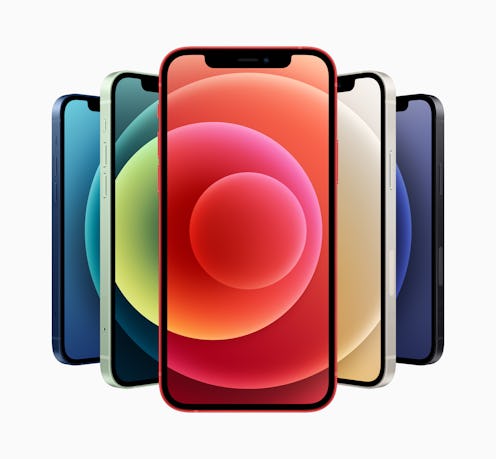Tech
From new colors to a better camera.
This week, Apple announced its latest smartphone: the iPhone 12. The latest iteration boasts everything from better cameras to higher screen quality to 5G capabilities. If you (and your bank account) are wondering how the iPhone 12 compares to the iPhone 11, you’ll be happy to know there are some key differences in this newest iPhone.
For starters, it comes in four different models. There’s the 5.4-inch iPhone 12 mini, the smallest of the bunch; a 6.1-inch iPhone 12, which is the same screen size as the iPhone 11; the 6.1-inch iPhone 12 Pro; and finally, the 6.7-inch iPhone 12 Pro Max, boasting a bigger screen than the 6.5-inch iPhone 11 Pro Max. In other words, Apple just released both its largest and smallest iPhones to-date.
There's also the introduction of MagSafe, a hyper-strong magnet meant to make wireless charging more efficient. Those aren't the only key difference in this newest smartphone from Apple. Here are five more major differences between the new iPhone 12 and the iPhone 11.
1
5G Capabilities
Among the biggest news from October's Apple event is, for the first time, all four new iPhone 12 models are compatible with 5G. What exactly does that mean for you? Paired with the new A14 chip, which Apple touts as the fastest chip in a smartphone, the iPhone 12 will have wider-spread access to faster speeds, quicker downloads, higher-quality streaming, and higher‑def FaceTiming. In other words, you won't need to rely as heavily on Wi-Fi hotspots in areas where 5G is accessible.
2
New Colors
It wouldn't be a new smartphone without new colors, and the new iPhone 12 comes in nine different colors. In addition to a new stainless steel frame (a la the first-generation iPhone SE), the iPhone 12 comes in a range of new colors: blue, green, black, white, and red for the iPhone 12 and iPhone 12 mini models; graphite, silver, gold, and the brand new pacific blue for the iPhone 12 Pro & iPhone 12 Pro Max.
3
Improved Screen Durability
Unlike its predecessors, the iPhone 12 has a Ceramic Shield front. Apple says this will improve the toughness of your phone screen, making it stronger than other smartphone glass currently on the market. Apple claims the screen is four times less likely to crack when dropped compared to previous iPhone screens. With the ability to withstand 6 meters deep for up to 30 minutes, the newest iPhone is more dust- and water-resistant than the iPhone 11. This is welcome news if you're prone to cracking your screen the moment get it.
4
Night Mode And A High-Quality Camera
Like the iPhone 11, the iPhone 12 and iPhone 12 Mini have dual-lens camera set-ups on the back. The iPhone 12 Pro and iPhone 12 Pro Max feature triple-lens camera arrays on the back a la the iPhone 11 Pro Max. Unlike previous models, the iPhone 12 can record in Dolby Vision HDR, making for the highest-quality video capture yet.
Additionally, the new iPhone 12 has Night Mode on all cameras including its front-facing camera. (The iPhone 11 only had the feature in its back cameras.) As its name suggests, Night Mode makes for better-quality photos in low-light settings.
5
Lower Starting Price
While you can currently get the iPhone 11 at a lower price ($599), Apple is releasing its higher-end iPhone 12 models at a more affordable price-point. Both the iPhone 12 Pro and iPhone 12 Pro Max are $50 less expensive than then Pro-model predecessors with the iPhone 12 Pro at $999 and the iPhone 12 Pro Max at $1,099.
This is notably less expensive than other 5G-compatible smartphones. The Samsung Galaxy Note 20 Ultra, for example, starts at a price point of $1,299. Apple's least expensive phone that supports 5G, a 64GB iPhone 12 mini, starts at $699, and its most expensive new model, a 512GB iPhone 12 Pro Max, is $1,399. The iPhone 12 starts at $799.
One caveat to that lower pricepoint: you won't get EarPods or a wall charger with your new phone. Apple says this is to reduce its packaging carbo footprint. You can either buy these separately at $19 each or use the AirPods and compatible-charger that you already have.
Starting Oct. 16, you'll be able to pre-order the iPhone 12 and iPhone 12 Pro, which will start shipping on Oct. 23. For the iPhone 12 mini and the iPhone 12 Pro Max, you'll have to wait until Nov. 6 to pre-order and Nov. 13 to ship.
This article was originally published on
